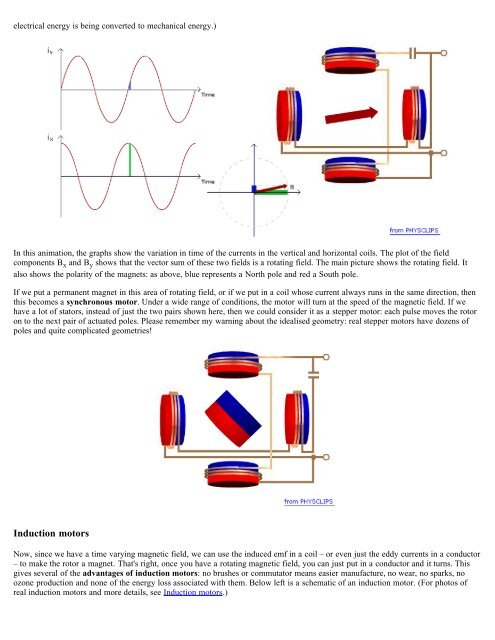How real electric motors work - School of Physics - The University of ...
How real electric motors work - School of Physics - The University of ...
How real electric motors work - School of Physics - The University of ...
You also want an ePaper? Increase the reach of your titles
YUMPU automatically turns print PDFs into web optimized ePapers that Google loves.
<strong>electric</strong>al energy is being converted to mechanical energy.)<br />
In this animation, the graphs show the variation in time <strong>of</strong> the currents in the vertical and horizontal coils. <strong>The</strong> plot <strong>of</strong> the field<br />
components B x and B y shows that the vector sum <strong>of</strong> these two fields is a rotating field. <strong>The</strong> main picture shows the rotating field. It<br />
also shows the polarity <strong>of</strong> the magnets: as above, blue represents a North pole and red a South pole.<br />
If we put a permanent magnet in this area <strong>of</strong> rotating field, or if we put in a coil whose current always runs in the same direction, then<br />
this becomes a synchronous motor. Under a wide range <strong>of</strong> conditions, the motor will turn at the speed <strong>of</strong> the magnetic field. If we<br />
have a lot <strong>of</strong> stators, instead <strong>of</strong> just the two pairs shown here, then we could consider it as a stepper motor: each pulse moves the rotor<br />
on to the next pair <strong>of</strong> actuated poles. Please remember my warning about the idealised geometry: <strong>real</strong> stepper <strong>motors</strong> have dozens <strong>of</strong><br />
poles and quite complicated geometries!<br />
Induction <strong>motors</strong><br />
Now, since we have a time varying magnetic field, we can use the induced emf in a coil – or even just the eddy currents in a conductor<br />
– to make the rotor a magnet. That's right, once you have a rotating magnetic field, you can just put in a conductor and it turns. This<br />
gives several <strong>of</strong> the advantages <strong>of</strong> induction <strong>motors</strong>: no brushes or commutator means easier manufacture, no wear, no sparks, no<br />
ozone production and none <strong>of</strong> the energy loss associated with them. Below left is a schematic <strong>of</strong> an induction motor. (For photos <strong>of</strong><br />
<strong>real</strong> induction <strong>motors</strong> and more details, see Induction <strong>motors</strong>.)
















